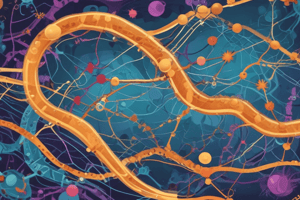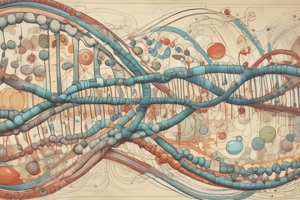Podcast
Questions and Answers
Which factor recognizes a termination codon and results in the release of the newly synthesized protein?
Which factor recognizes a termination codon and results in the release of the newly synthesized protein?
- RF-1
- EF-2
- RF-2
- RF-3 (correct)
What is the function of polyribosomes in a cell?
What is the function of polyribosomes in a cell?
- To enable quick synthesis of DNA
- To facilitate cell division
- To help in the repair of damaged cell membranes
- To make many copies of a polypeptide quickly (correct)
In prokaryotic translation, what is the function of formylated initiator tRNA?
In prokaryotic translation, what is the function of formylated initiator tRNA?
- Promotes coupling of transcription and translation
- Facilitates the translocation of ribosomes
- Prevents premature termination of translation
- Recognizes the start codon in mRNA (correct)
Which antibiotic blocks elongation by preventing aminoacyl-tRNA access to the A-site?
Which antibiotic blocks elongation by preventing aminoacyl-tRNA access to the A-site?
What is the role of miRNA in inhibiting translation?
What is the role of miRNA in inhibiting translation?
What type of post-translational modification involves the formation of disulphide bridges?
What type of post-translational modification involves the formation of disulphide bridges?
What is the main function of zymogens or proenzymes?
What is the main function of zymogens or proenzymes?
Which amino acid side chain does protein phosphorylation usually occur on?
Which amino acid side chain does protein phosphorylation usually occur on?
What is the main characteristic feature of polyribosomes?
What is the main characteristic feature of polyribosomes?
What is the function of diphtheria toxin inactivation by ADP-ribosylation?
What is the function of diphtheria toxin inactivation by ADP-ribosylation?
What is the role of cycloheximide in eukaryotic cells?
What is the role of cycloheximide in eukaryotic cells?
Which organelle is responsible for the N-linked carbohydrate chains attachment to the amide nitrogen of Asn residue?
Which organelle is responsible for the N-linked carbohydrate chains attachment to the amide nitrogen of Asn residue?
What is the function of farnesyl group in the cell?
What is the function of farnesyl group in the cell?
What is the clinical value of measuring C-peptide levels?
What is the clinical value of measuring C-peptide levels?
Where does the maturation of insulin occur?
Where does the maturation of insulin occur?
What is the role of signal sequence in protein translation?
What is the role of signal sequence in protein translation?
What is the function of the Shine-Dalgarno sequence in prokaryotic translation?
What is the function of the Shine-Dalgarno sequence in prokaryotic translation?
What is the role of the elongation factor EF-Tu-GTP in prokaryotic translation?
What is the role of the elongation factor EF-Tu-GTP in prokaryotic translation?
Which of the following statements is true regarding the initiator tRNA in prokaryotic translation?
Which of the following statements is true regarding the initiator tRNA in prokaryotic translation?
In prokaryotic translation, what is the function of the release factor (RF) during termination?
In prokaryotic translation, what is the function of the release factor (RF) during termination?
What is the role of initiation factors (IFs) in prokaryotic translation?
What is the role of initiation factors (IFs) in prokaryotic translation?
What distinguishes the Shine-Dalgarno sequence in prokaryotes from eukaryotic translation initiation in terms of ribosome binding?
What distinguishes the Shine-Dalgarno sequence in prokaryotes from eukaryotic translation initiation in terms of ribosome binding?
Which statement accurately describes the role of EF-G-GTP during prokaryotic translation?
Which statement accurately describes the role of EF-G-GTP during prokaryotic translation?
'Charging' of tRNA involves:
'Charging' of tRNA involves:
'Formylation' of N-formylmethionine (fMet) carried by initiator tRNA signifies:
'Formylation' of N-formylmethionine (fMet) carried by initiator tRNA signifies:
'Elongation factor EF-Tu-GTP' functions primarily to:
'Elongation factor EF-Tu-GTP' functions primarily to:
What distinguishes 'Initiator transfer RNAi' from 'Normal Met-tRNA'?
What distinguishes 'Initiator transfer RNAi' from 'Normal Met-tRNA'?
Flashcards are hidden until you start studying





